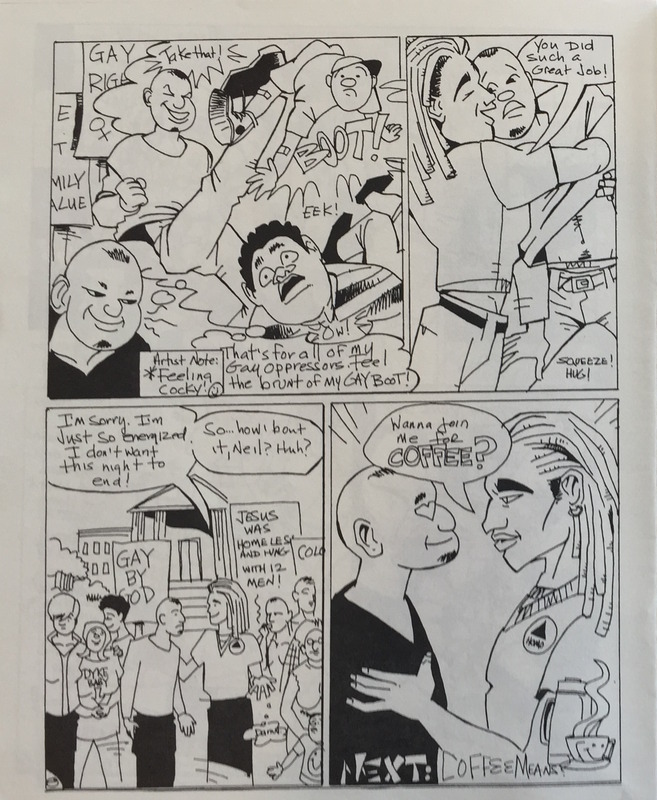In US culture, the media continuously portrays black men as masculine and oftentimes even hypermasculine figures. Yet within communities of black men, author Clyde Franklin observed that “black gay men, because of their homosexuality, may not be perceived as masculine by straight black men” (15). This phenomenon, as anthropologists Charles Callender and Lee Kochems elaborately explain, is based within the notion that “our gender system recognizes only the two gender statuses of men and women” and because of this “homosexual men are perceived as behaving too much like women…and as imperfect members of the men’s status” (175-6). Fueled in part by these assumptions, many black gay writers, like the author of Black Gay Boy Fantasy, Victor E. Hodge, have used their work to speak against these implications. Through the scene displayed by this image, Black Gay Boy Fantasy abolishes traditional stereotypes of queer black masculinity in order to create new and perhaps more accurate representations of queer black masculinity within black male communities.
Through an assumed absence of sexuality, black gay men are often denied access into any version of masculinity. In Sheila J. Wise’s article "Redefining Black Masculinity and Manhood," Wise asserts that sexuality, which is regarded as basis of manhood, “is alluded to within the context of procreation and male/female relationships” (20). Because of these expectations, black gay men are presumed to have no sexuality and therefore are “not a part of manhood” (Wise 20). Yet, in Black Gay Boy Fantasy, the main character, Neil, is actively shown engaging with his sexuality. While dazed in a gentle embrace with heart shaped eyes, Neil shows that he is in fact capable of forming a new version of sexuality outside of the typical heterosexual example. This simple panel pushes against the barrier of believed asexuality and begins to create a space for more black gay representations within in the greater representations of black masculinity.
Later in her analysis of black masculinity, Wise observes that “being gay or more specifically engaging in homosexual activity reduces or minimizes ones standing as a masculine black man” (13). Yet, once again, Black Gay Boy Fantasy dismantles another stereotype placed upon black gay men. In the first panel, Neil is shown imagining himself beating up and ridding the world of the deniers of gay marriage and equality. While the depiction is a thought rather than an action, it still implies that Neil has desires associated with heteronormative masculinity. Though a fantasy, the image helps viewers imagine and perceive Neil as a strong and strong-willed black gay man and thus allows him to take part in more of the traditional representations of black masculinity. The image also portrays Neil to be a superhero like figure –the ultimate heteronormative example of masculinity–within the scene. In the first panel, Neil is shown to be protecting the gay community from the agenda of the evil tormentors as he “boot[s]” them away. Much like the traditional superhero, Neil saves the oppressed from their oppressors while this adoring fans swarm him with adoration.
Callender, Charles, and Lee M. Kochems. "Men and Not-Men:." Journal of Homosexuality 11.3-4 (1986): 165-78. Web.
Franklin, Clyde W. "Men’s studies, the men’s movement, and the study of Black masculinities: Further demystification of masculinities in America." The American Black Male: His present status and his future. Chicago: Nelson-Hall(1994). Web.
Hodge, Victor E. "Black Gay Boy Fantasy." Vol. 1. N.p.: New Blood Illustrations, 1998. Print.
Wise, Sheila J. "Redefining Black Masculinity and Manhood: Successful Black Gay Men Speak out." Journal of African American Men 5.4 (2001): 3-22. Web.
